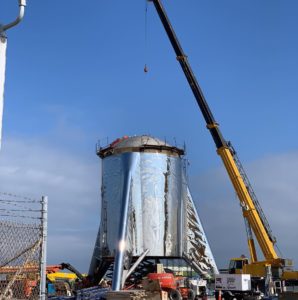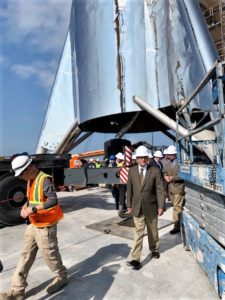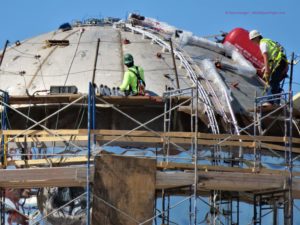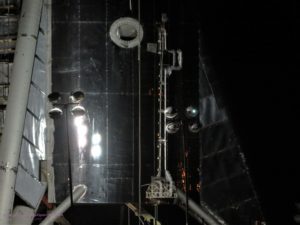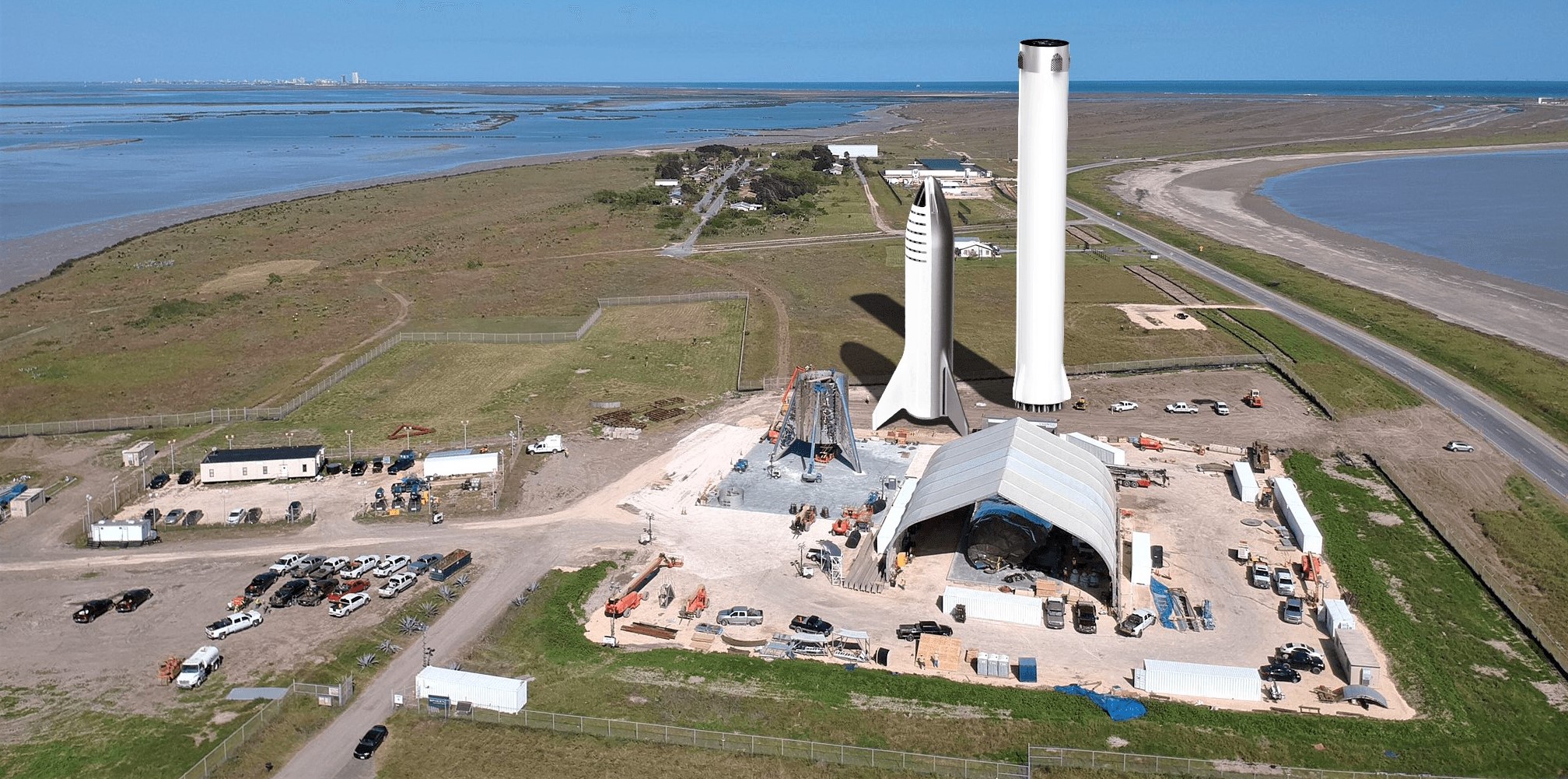

SpaceX
SpaceX job posts confirm Starship’s Super Heavy booster will be built in Texas
A duo of SpaceX job postings at the company’s South Texas facilities have confirmed that both Starship and Super Heavy “flight article” vehicles will initially be fabricated and assembled on-site in Boca Chica, also implying that the rocket’s first orbital launch attempts will occur in the same vicinity.
Construction of the first massive Super Heavy booster could begin in Boca Chica within the next several months, presumably progressing in a similar fashion to Starship’s full-scale hopper prototype. According to CEO Elon Musk, Starhopper hop tests and Super Heavy construction could begin – respectively – as early as March and April 2019, perhaps just one or two months from now.

Where to build a giant rocket?
“Tank fabricators will work to build the primary airframe of the Starship and Super Heavy vehicles at the SpaceX South Texas build site. [They] will work with an elite team of other fabricators and technicians to rapidly build the tank (cylindrical structure), tank bulkheads, and other large associated structures for the flight article design of both vehicles.” – SpaceX, 02/15/19
Posted on February 15th, both open positions centered around structural assembly (i.e. welding) critical for the construction of the massive propellant tank domes, barrel sections, and other major structure of Starship and Super Heavy. Following an unanticipated pivot to stainless steel – rather than advanced carbon composites – as the primary structural material of choice for BFR, the project has been continually marked by a flurry of impressive technical progress at the same time as many previously foundational aspects became uncertain.
Most notably, SpaceX appeared to terminate a lease agreement it had held with the Port of Los Angeles for a large berth meant to be developed into a dedicated factory for BFR’s massive spaceship upper stage and booster, whose 9m (~30 foot) diameter would have been highly impractical to build somewhere that wasn’t either at the rocket’s launch site or directly adjacent to a port. With its headquarters in Hawthorne, CA (southwestern Los Angeles), SpaceX’s first choice was unsurprisingly the Port of LA, a location that would have allowed its 5000+ local employees to have seamlessly transferred to the BFR program without requiring highly disruptive relocations.
The source info is incorrect. Starship & Raptor development is being done out of our HQ in Hawthorne, CA. We are building the Starship prototypes locally at our launch site in Texas, as their size makes them very difficult to transport.
— Elon Musk (@elonmusk) January 16, 2019
Known as Berth 240, SpaceX’s lease began in March 2018 but was reportedly terminated in January 2019, likely meaning that the company will have to vacate the premises next month. While an official SpaceX statement and subsequent Elon Musk tweets relating to that report served to partially correct the record and confirm that “Starship prototypes” would be built locally in South Texas, Super Heavy was never mentioned. SpaceX’s latest job postings complete the image, indicating that all aspects of the first Starship and Super Heavy prototypes will be assembled in South Texas.
Weighing just shy of 4.5 million kilograms (~10M lbs) fully-fueled and standing around 118m (387 ft) tall with both stages stacked together, BFR is a beast of a launch vehicle and will require wholly new methods of production and assembly thanks to its sheer scale and the extensive integration of stainless steel alloys into its design. Compared to SpaceX’s Falcon 9 rocket, which is by no means small, Super Heavy on its own could end up being 68m (224 ft) tall, just slightly shorter than a complete Falcon 9 with a booster, upper stage, and fairing (71m, 233 ft). Standing on its tripod fins, Starship stands around 55m (180 ft) tall, although all of these figures are liable to change, as they come from a September 2018 SpaceX presentation that occurred before Musk publicized the move to stainless steel.
Ask and you shall receive! Here's an image with the mighty #SaturnV compared to the @SpaceX's upcoming #Starship and #Superheavy stack! Really gives a sense of scale how truly massive the rocket will be! 🤯
This and many of my other renders are now also available at my shop! pic.twitter.com/qTscwzWyKF
— Kimi Talvitie (@kimitalvitie) January 12, 2019
Likely to remain unchanged is the diameter of Starship and Super Heavy: 9m (30 ft), roughly 2.5 times wider than Falcon 9’s booster and upper stage. Even more true for a 9m-diameter rocket also meant to rely on a partial implementation of stainless steel balloon tanks, transporting Starship and Super Heavy more than a few thousand feet horizontally is going to be an extraordinary challenge, although SpaceX’s Boca Chica facilities are conveniently located just a mile or less from the Gulf of Mexico. While road transport is entirely out of the question, Saturn V’s massive first and second stage boosters proved to be relatively easy to transport thanks to the production facility being directly adjacent to a large body of water (or a river to get there, in their case).
“For all their prodigious bulk, [Saturn V’s 33.0 ft (10.1 m) diameter first and second stages] could be transported with comparative ease via seagoing barges [from Michoud, Louisiana to Cape Canaveral, Florida].” – Roger Bilstein/NASA, p. 301
Assuming SpaceX chooses to assemble Super Heavy with the same vertical, outdoors approach, Boca Chica, Texas is going to be greeted by a view even more exotic than the already-impressive progress being made with Starship’s Starhopper prototype. CEO Elon Musk noted that he believed the first Super Heavy prototype would begin to be built this spring (as early as April). In the meantime, SpaceX continues to exploit the benefits of stainless steel whenever it can, utilizing the company’s wealth of Hawthorne, CA expertise and infrastructure to fabricate subassemblies that can easily be shipped by road or plane to South Texas. After arrival, Boca Chica-based employees or contractors can be tasked with the considerably less infrastructure-intensive work of final assembly and integration, a challenging and critical process but one that is at least slightly more setting-agnostic.
- Local representatives were given tours of SpaceX’s Boca Chica facilities and work earlier this week. (Alex Dominguez – 02/10/19)
- (Bobby Guerra – 02/11/19)
- Aerospace-grade bubble wrap! (NASASpaceflight – bocachicagal)
- Much like Falcon 9, Starhopper has begun to be outfitted with plumbing necessary to pressurize and fill its propellant tanks, among other things. (NASASpaceflight – bocachicagal)
SpaceX’s propulsion team continues to test the first full-scale Raptor engine a few hundred miles north of Boca Chica while Starhopper is gradually outfitted with a range of avionics, wiring, and plumbing needed for the vehicle’s hop test debut. That could come as early as March, according to Musk, although further delays should come as no surprise.
Check out Teslarati’s newsletters for prompt updates, on-the-ground perspectives, and unique glimpses of SpaceX’s rocket launch and recovery processes!
News
SpaceX launches Ax-4 mission to the ISS with international crew
The SpaceX Falcon 9 launched Axiom’s Ax-4 mission to ISS. Ax-4 crew will conduct 60+ science experiments during a 14-day stay on the ISS.
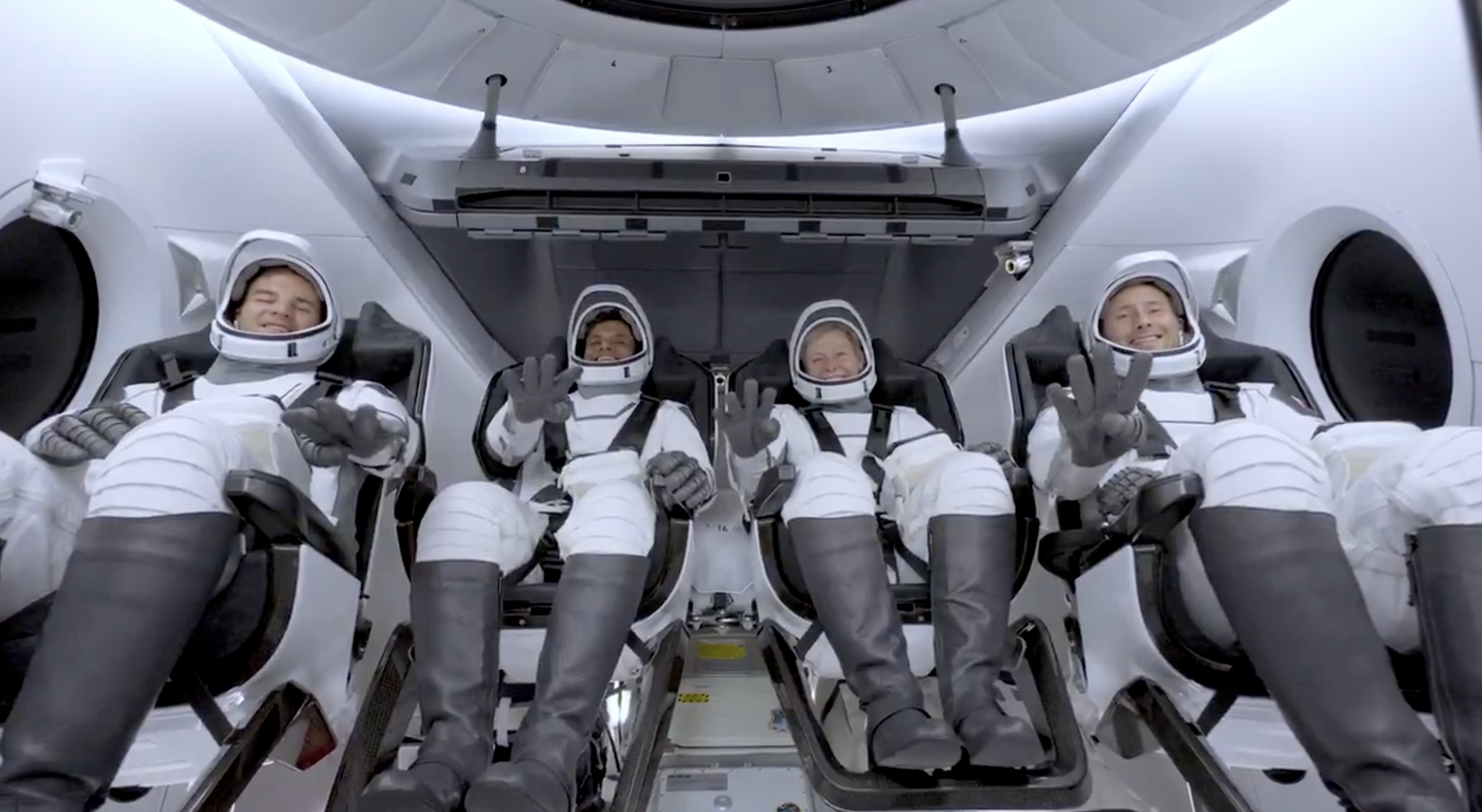
SpaceX launched the Falcon 9 rocket kickstarting Axiom Space’s Ax-4 mission to the International Space Station (ISS). Axiom’s Ax-4 mission is led by a historic international crew and lifted off from Kennedy Space Center’s Launch Complex 39A at 2:31 a.m. ET on June 25, 2025.
The Ax-4 crew is set to dock with the ISS around 7 a.m. ET on Thursday, June 26, 2025. Axiom Space, a Houston-based commercial space company, coordinated the mission with SpaceX for transportation and NASA for ISS access, with support from the European Space Agency and the astronauts’ governments.
The Ax-4 mission marks a milestone in global space collaboration. The Ax-4 crew, commanded by U.S. astronaut Peggy Whitson, includes Shubhanshu Shukla from India as the pilot, alongside mission specialists Sławosz Uznański-Wiśniewski from Poland and Tibor Kapu from Hungary.
“The trip marks the return to human spaceflight for those countries — their first government-sponsored flights in more than 40 years,” Axiom noted.
Shukla’s participation aligns with India’s Gaganyaan program planned for 2027. He is the first Indian astronaut to visit the ISS since Rakesh Sharma in 1984.
Axiom’s Ax-4 mission marks SpaceX’s 18th human spaceflight. The mission employs a Crew Dragon capsule atop a Falcon 9 rocket, designed with a launch escape system and “two-fault tolerant” for enhanced safety. The Axiom mission faced a few delays due to weather, a Falcon 9 leak, and an ISS Zvezda module leak investigation by NASA and Roscosmos before the recent successful launch.
As the crew prepares to execute its scientific objectives, SpaceX’s Ax-4 mission paves the way for a new era of inclusive space research, inspiring future generations and solidifying collaborative ties in the cosmos. During the Ax-4 crew’s 14-day stay in the ISS, the astronauts will conduct nearly 60 experiments.
“We’ll be conducting research that spans biology, material, and physical sciences as well as technology demonstrations,” said Whitson. “We’ll also be engaging with students around the world, sharing our experience and inspiring the next generation of explorers.”
SpaceX’s Ax-4 mission highlights Axiom’s role in advancing commercial spaceflight and fostering international partnerships. The mission strengthens global space exploration efforts by enabling historic spaceflight returns for India, Poland, and Hungary.
News
Starlink Cellular’s T-Mobile service to grow with third-party app data
From Oct 2025, T-Satellite will enable third-party apps in dead zones! WhatsApp, X, AccuWeather + more coming soon.

Starlink Cellular’s T-Mobile service will expand with third-party app data support starting in October, enhancing connectivity in cellular dead zones.
T-Mobile’s T-Satellite, supported by Starlink, launches officially on July 23. Following its launch, T-Mobile’s Starlink Cellular service will enable data access for third-party apps like WhatsApp, X, Google, Apple, AccuWeather, and AllTrails on October 1, 2025.
T-Mobile’s Starlink Cellular is currently in free beta. T-Satellite will add MMS support for Android phones on July 23, with iPhone support to follow. MMS support allows users to send images and audio clips alongside texts. By October, T-Mobile will extend emergency texting to all mobile users with compatible phones, beyond just T-Mobile customers, building on its existing 911 texting capability. The carrier also provides developer tools to help app makers integrate their software with T-Satellite’s data service, with plans to grow the supported app list.
T-Mobile announced these updates during an event celebrating an Ookla award naming it the best U.S. phone network, a remarkable turnaround from its last-place ranking a decade ago.
“We not only dream about going from worst to best, we actually do it. We’re a good two years ahead of Verizon and AT&T, and I believe that lead is going to grow,” said T-Mobile’s Chief Operating Officer Srini Gopalan.
T-Mobile unveiled two promotions for its Starlink Cellular services to attract new subscribers. A free DoorDash DashPass membership, valued at $10/month, will be included with popular plans like Experience Beyond and Experience More, offering reduced delivery and service fees. Meanwhile, the Easy Upgrade promotion targets Verizon customers by paying off their phone balances and providing flagship devices like the iPhone 16, Galaxy S25, or Pixel 9.
T-Mobile’s collaboration with SpaceX’s Starlink Cellular leverages orbiting satellites to deliver connectivity where traditional networks fail, particularly in remote areas. Supporting third-party apps underscores T-Mobile’s commitment to enhancing user experiences through innovative partnerships. As T-Satellite’s capabilities grow, including broader app integration and emergency access, T-Mobile is poised to strengthen its lead in the U.S. wireless market.
By combining Starlink’s satellite technology with strategic promotions, T-Mobile is redefining mobile connectivity. The upcoming third-party app data support and official T-Satellite launch mark a significant step toward seamless communication, positioning T-Mobile as a trailblazer in next-generation wireless services.
News
Starlink expansion into Vietnam targets the healthcare sector
Starlink aims to deliver reliable internet to Vietnam’s remote clinics, enabling telehealth and data sharing.

SpaceX’s Starlink expansion into Vietnam targets its healthcare sector. Through Starlink, SpaceX seeks to drive digital transformation in Vietnam.
On June 18, a SpaceX delegation met with Vietnam’s Ministry of Health (MoH) in Hanoi. SpaceX’s delegation was led by Andrew Matlock, Director of Enterprise Sales, and the discussions focused on enhancing connectivity for hospitals and clinics in Vietnam’s remote areas.
Deputy Minister of Health (MoH) Tran Van Thuan emphasized collaboration between SpaceX and Vietnam. Tran stated: “SpaceX should cooperate with the MoH to ensure all hospitals and clinics in remote areas are connected to the StarLink satellite system and share information, plans, and the issues discussed by members of the MoH. The ministry is also ready to provide information and send staff to work with the corporation.”
The MoH assigned its Department of Science, Technology, and Training to work with SpaceX. Starlink Vietnam will also receive support from Vietnam’s Department of International Cooperation. Starlink Vietnam’s agenda includes improving internet connectivity for remote healthcare facilities, developing digital infrastructure for health examinations and remote consultations, and enhancing operational systems.
Vietnam’s health sector is prioritizing IT and digital transformation, focusing on electronic health records, data centers, and remote medical services. However, challenges persist in deploying IT solutions in remote regions, prompting Vietnam to seek partnerships like SpaceX’s.
SpaceX’s Starlink has a proven track record in healthcare. In Rwanda, its services supported 40 health centers, earning praise for improving operations. Similarly, Starlink enabled remote consultations at the UAE’s Emirati field hospital in Gaza, streamlining communication for complex medical cases. These successes highlight Starlink’s potential to transform Vietnam’s healthcare landscape.
On May 20, SpaceX met with Vietnam’s Ministry of Industry and Trade, announcing a $1.5 billion investment to provide broadband internet, particularly in remote, border, and island areas. The first phase includes building 10-15 ground stations across the country. This infrastructure will support Starlink’s healthcare initiatives by ensuring reliable connectivity.
Starlink’s expansion in Vietnam aligns with the country’s push for digital transformation, as outlined by the MoH. By leveraging its satellite internet expertise, SpaceX aims to bridge connectivity gaps, enabling advanced healthcare services in underserved regions. This collaboration could redefine Vietnam’s healthcare infrastructure, positioning Starlink as a key player in the nation’s digital future.
-

 Elon Musk2 days ago
Elon Musk2 days agoTesla investors will be shocked by Jim Cramer’s latest assessment
-

 News7 days ago
News7 days agoTesla Robotaxi’s biggest challenge seems to be this one thing
-

 News2 weeks ago
News2 weeks agoTesla’s Grok integration will be more realistic with this cool feature
-

 Elon Musk2 weeks ago
Elon Musk2 weeks agoElon Musk slams Bloomberg’s shocking xAI cash burn claims
-

 News2 weeks ago
News2 weeks agoTesla China roars back with highest vehicle registrations this Q2 so far
-

 News2 weeks ago
News2 weeks agoTexas lawmakers urge Tesla to delay Austin robotaxi launch to September
-

 News2 weeks ago
News2 weeks agoTesla dominates Cars.com’s Made in America Index with clean sweep
-

 Elon Musk1 week ago
Elon Musk1 week agoFirst Look at Tesla’s Robotaxi App: features, design, and more

